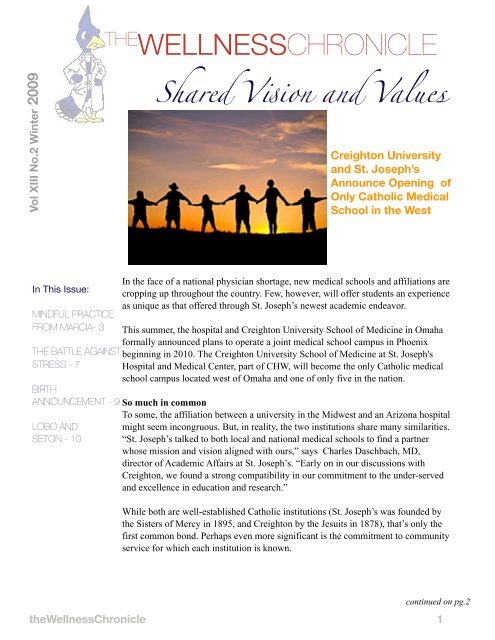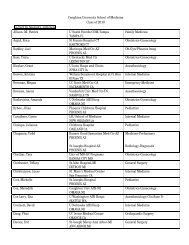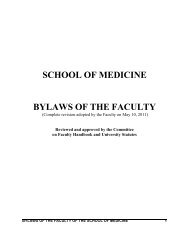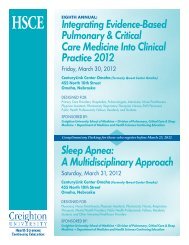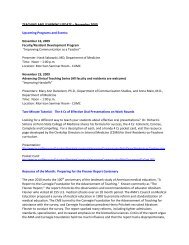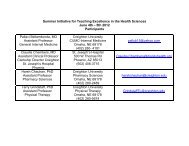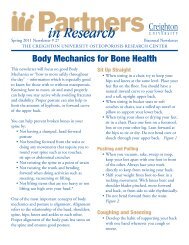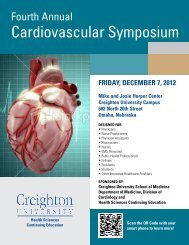Wellness Chronicle - Creighton University School of Medicine
Wellness Chronicle - Creighton University School of Medicine
Wellness Chronicle - Creighton University School of Medicine
Create successful ePaper yourself
Turn your PDF publications into a flip-book with our unique Google optimized e-Paper software.
Vol XIII No.2 Winter 2009<br />
In This Issue:<br />
MINDFUL PRACTICE<br />
FROM MARCIA- 3<br />
THE BATTLE AGAINST<br />
STRESS - 7<br />
BIRTH<br />
ANNOUNCEMENT - 9<br />
LOBO AND<br />
SETON - 10<br />
THE WELLNESSCHRONICLE<br />
Shared V!ion and Values<br />
<strong>Creighton</strong> <strong>University</strong><br />
and St. Joseph’s<br />
Announce Opening <strong>of</strong><br />
Only Catholic Medical<br />
<strong>School</strong> in the West<br />
In the face <strong>of</strong> a national physician shortage, new medical schools and affiliations are<br />
cropping up throughout the country. Few, however, will <strong>of</strong>fer students an experience<br />
as unique as that <strong>of</strong>fered through St. Joseph’s newest academic endeavor.<br />
This summer, the hospital and <strong>Creighton</strong> <strong>University</strong> <strong>School</strong> <strong>of</strong> <strong>Medicine</strong> in Omaha<br />
formally announced plans to operate a joint medical school campus in Phoenix<br />
beginning in 2010. The <strong>Creighton</strong> <strong>University</strong> <strong>School</strong> <strong>of</strong> <strong>Medicine</strong> at St. Joseph's<br />
Hospital and Medical Center, part <strong>of</strong> CHW, will become the only Catholic medical<br />
school campus located west <strong>of</strong> Omaha and one <strong>of</strong> only five in the nation.<br />
So much in common<br />
To some, the affiliation between a university in the Midwest and an Arizona hospital<br />
might seem incongruous. But, in reality, the two institutions share many similarities.<br />
“St. Joseph’s talked to both local and national medical schools to find a partner<br />
whose mission and vision aligned with ours,” says Charles Daschbach, MD,<br />
director <strong>of</strong> Academic Affairs at St. Joseph’s. “Early on in our discussions with<br />
<strong>Creighton</strong>, we found a strong compatibility in our commitment to the under-served<br />
and excellence in education and research.”<br />
While both are well-established Catholic institutions (St. Joseph’s was founded by<br />
the Sisters <strong>of</strong> Mercy in 1895, and <strong>Creighton</strong> by the Jesuits in 1878), that’s only the<br />
first common bond. Perhaps even more significant is the commitment to community<br />
service for which each institution is known.<br />
continued on pg.2<br />
the<strong>Wellness</strong><strong>Chronicle</strong> 1
THE WELLNESS<br />
CHRONICLE<br />
STAFF<br />
FACULTY ADVISOR<br />
Dr. Michael Kavan, Ph.D.<br />
EDITORS IN CHIEF<br />
Maryal Concepcion<br />
Roberto Cervantes<br />
THIS ISSUE’S AUTHORS<br />
Michelle Millard<br />
Linda Pappas<br />
Marcia Cusic<br />
Kim Truong<br />
Amanda Oertli<br />
Allison Rasband-Lindquist<br />
David Nash<br />
Lindsey Minion<br />
Article Contents:<br />
SHARED VISION AND VALUES 1<br />
MINDFUL PRACTICE 4<br />
MAGIS CLINIC 5<br />
THE LEARNING CYCLE 6<br />
THE BATTLE AGAINST STRESS 7<br />
BIRTH ANNOUNCEMENT 9<br />
LOBO AND SETON 10<br />
ALL PROFESSIONAL 10<br />
THE BIG NEWS 11<br />
Shared Vision and Values - continued from pg. 1<br />
In fact, both are recent recipients <strong>of</strong> the Association <strong>of</strong> American Medical<br />
Colleges’ Spencer Foreman Award for Outstanding Community Service. St.<br />
Joseph’s dedication to the community spans more than a century, while<br />
<strong>Creighton</strong>’s medical students must demonstrate a strong record <strong>of</strong> community<br />
service before being accepted. Then, while studying at <strong>Creighton</strong>, the medical<br />
students operate the Magis Clinic, a free health clinic in Omaha.<br />
Another shared bond is a commitment to<br />
high-quality education and research.<br />
Ranked among the most “wired”<br />
universities, <strong>Creighton</strong> has set the bar<br />
high in terms <strong>of</strong> innovative teaching from<br />
faculty as well as learning-effort<br />
expectations from students in this unique<br />
educational affiliation with St. Joseph’s, says Dr. Daschbach.<br />
Thuy Koll (m3)<br />
Energizer bunnies<br />
Teaching medical students is nothing new to St. Joseph’s. The hospital hosts students<br />
from more than 60 institutions on a rotating basis. There are about 25 medical<br />
students on campus at any given time. Once the <strong>Creighton</strong> affiliation is fully<br />
implemented, that number will jump to more than 100. And that’s a good thing, for<br />
plenty <strong>of</strong> reasons. “Medical students energize teaching hospitals,” explains Dr. Daschbach. “The opportunity to shape<br />
young physicians in their earliest clinical experiences energizes all <strong>of</strong> us, especially nurses, other support staff, and<br />
faculty.”<br />
Teaching hospitals also count on this positive energy to attract residents, and where physicians complete their residency is<br />
a good indicator <strong>of</strong> where they will end up practicing medicine in the long run. This is good news in a state that has a<br />
growing physician shortage.<br />
Reaping the benefits<br />
<strong>Creighton</strong> students started coming to St. Joseph’s for month-long rotations in a handful <strong>of</strong> specialties in 2005, and the<br />
hospital is already reaping the benefits <strong>of</strong> the partnership. Danielle Potter, MD, is a first-year OB/GYN resident at St.<br />
Joseph’s and a <strong>Creighton</strong> alumna.<br />
continued on pg.3<br />
the<strong>Wellness</strong><strong>Chronicle</strong> 2
Shared Vision and Values - continued from pg. 2<br />
She completed rotations at St. Joseph’s during her<br />
third and fourth years <strong>of</strong> medical school at <strong>Creighton</strong><br />
and was happy to return to the hospital as a resident<br />
this summer. From a student perspective, she thinks<br />
that the geographic arrangement <strong>of</strong> the new medical<br />
school will <strong>of</strong>fer some distinct advantages.<br />
“Not only is it a benefit to students to get to<br />
experience two different environments, but they will<br />
be exposed to different patient populations as well,”<br />
says Dr. Potter. “For example, there’s a larger<br />
Hispanic population in Phoenix than there is in<br />
Omaha, so students are seeing a different clinical<br />
spectrum. I think it’s an added benefit to their<br />
education.”<br />
Dan Farber (m3)<br />
The class <strong>of</strong> 2014<br />
The selection process for the first class <strong>of</strong> 42 students<br />
is just getting underway. Beginning in July 2010,<br />
those students will spend their first two years<br />
receiving classroom instruction in Omaha and then<br />
will spend their third and fourth years doing clinical<br />
rotations at St. Joseph’s. The first Phoenix medical<br />
student class will graduate in 2014.<br />
As the program progresses, St. Joseph’s is looking<br />
forward to becoming a more integral part <strong>of</strong> the<br />
<strong>Creighton</strong> team, even before students arrive for their<br />
third-year rotations. For starters, the medical school<br />
and the hospital will appoint an associate dean,<br />
whose primary role will be to oversee the regional<br />
medical campus and ensure that all LCME (Liaison<br />
Committee on Medical Education) requirements are<br />
being met by early next year. From there, even more<br />
benefits will fall into place. <strong>Creighton</strong> has very<br />
competitive pharmacy and nursing schools, and<br />
further opportunities will be explored.<br />
“Many <strong>of</strong> our faculty members already have clinical<br />
appointments with <strong>Creighton</strong>, but we look forward to<br />
playing a larger role on the <strong>Creighton</strong> team, whether<br />
through the student selection process or participating<br />
in lectures or by collaborating on research,” says<br />
John Boyd, MD, St. Joseph’s chief medical <strong>of</strong>ficer.<br />
“Eventually, we will have representation on all key<br />
committees, which will lead to scholarly activity<br />
growth, education growth, and curricular growth.”<br />
At the same time, St. Joseph’s will continue its<br />
academic and research relationships with the<br />
<strong>University</strong> <strong>of</strong> Arizona College <strong>of</strong> <strong>Medicine</strong>, Arizona<br />
State <strong>University</strong>, the Translational Genomics<br />
Research Institute, and more than 20 other medical<br />
schools.<br />
“The new partnership with <strong>Creighton</strong> demonstrates<br />
our commitment to medical education at all levels,”<br />
says Linda Hunt, service area president for Catholic<br />
Healthcare West Arizona and president and CEO <strong>of</strong><br />
St. Joseph’s.<br />
Kim Daniel (m3)<br />
Reprinted with permission from the editor <strong>of</strong> St. Joseph’s<br />
Magazine, Catherine Menor.<br />
the<strong>Wellness</strong><strong>Chronicle</strong> 3
Mindful Practice:<br />
Working on the Perfect<br />
Life<br />
by<br />
Marcia Shadle-Cusic<br />
Mindfulness refers to a quality <strong>of</strong><br />
awareness that includes the ability<br />
to pay attention in a particular<br />
way - on purpose, in the present<br />
moment, and non-judgmentally. It<br />
is the ability to notice, observe<br />
and experience bodily sensations,<br />
thoughts and feelings even if they<br />
may be unpleasant, acting with<br />
awareness and attention (not being<br />
on autopilot), and focusing on the<br />
experience at hand.<br />
As busy people, practicing<br />
mindfulness reminds us to pay<br />
attention to the leaves crunching<br />
beneath our feet, to the warmth <strong>of</strong><br />
our first cup <strong>of</strong> c<strong>of</strong>fee on a cold<br />
day, to the response we receive<br />
when we greet another person<br />
with, "How are you?"<br />
When we practice mindfulness we<br />
are filling our spirits up with<br />
goodness; we are building up our<br />
reserves for what will happen on a<br />
particular day.<br />
Mindfulness, in many ways, can<br />
be explained in the Jesuit value <strong>of</strong><br />
"Finding God in all things." When<br />
we allow ourselves to be in the<br />
moment, we can take away from<br />
that moment wisdom, pleasure,<br />
relaxation, understanding <strong>of</strong><br />
ourselves and <strong>of</strong> others. Practicing<br />
mindfulness can lead to<br />
greater awareness and a more<br />
enlightened life. If practice makes<br />
perfect, then perhaps practicing<br />
mindfulness may lead us to the<br />
perfect life!<br />
May God continue to bless all <strong>of</strong> our<br />
lives,<br />
~Marcia<br />
Mindfulness Practice<br />
Session:<br />
Working on the Perfect<br />
LIfe<br />
Location:<br />
Marcia’s Office.<br />
the<strong>Wellness</strong><strong>Chronicle</strong> 4
Magis Clinic - Pediatric Vaccination Clinic<br />
by Kim Truong and Allison Rasband-Lindquist<br />
75 Children: Smiling and ready for<br />
school this fall after attending the<br />
Magis Pediatric Vaccination Clinics!<br />
This past summer, Magis sponsored two Pediatric Back-to-<strong>School</strong> Vaccination<br />
Clinics, one in North and one in South Omaha. Children were <strong>of</strong>fered free<br />
school physicals, immunizations, and backpacks filled with colorful new<br />
school supplies.<br />
During the Florence Clinic, kids were taught Body Basics using sheep eyes<br />
and hearts and human bones! In addition, the kids played on a fire truck and<br />
learned about fire safety from the Omaha Fire Department.<br />
At the end <strong>of</strong> the day, over 75 pediatric patients were seen and examined by<br />
our physician and student volunteers! Children ranged in ages from 2 to<br />
16-years-old, most <strong>of</strong> whom were uninsured or underinsured. Of the 110<br />
backpacks given away, over 30 went to recently immigrated children.<br />
Thank you M1s through M4s for all your support and generosity! It is only<br />
with your help that the Magis Clinic can continue running great programs<br />
such as the Pediatric Vaccination Clinics! This has been an extremely<br />
successful year for Magis and we are looking forward to many more!<br />
Pediatric patients show <strong>of</strong>f their new backpacks<br />
stuffed with colorful school supplies!<br />
Pediatric patients excitedly show <strong>of</strong>f their<br />
sheep eye dissections at the Pediatric<br />
Vaccination Clinic!<br />
the<strong>Wellness</strong><strong>Chronicle</strong> 5
The Learning Cycle<br />
By Linda Pappas<br />
The cycle that we go through to learn something is<br />
not something that most <strong>of</strong> us ever give much<br />
thought. We can learn how to be more effective as<br />
learners if we do pause to reflect on what happens.<br />
How do we grow those dendrites and create the<br />
massive neural networks that help us to answer that<br />
exam question correctly? Dr. John Pelley, who spoke<br />
at Vital Signs this semester, referred to the book “The<br />
Art <strong>of</strong> Changing the Brain” by James Zull, (2000,<br />
Stylus). In that book Zull describes David Kolb’s<br />
Learning Cycle. That cycle is described as a four<br />
step process which Zull explains happens in four<br />
parts <strong>of</strong> the brain:<br />
1. Concrete experience—take in information though the senses (lecture, podcast, lab). It is happening in the<br />
parietal lobes.<br />
2. Reflective observation—compare information with stored knowledge to determine if it is new or already<br />
known (taking notes). It is happening in the temporal lobes.<br />
3. Generalizations and abstract concepts—connect the new information with what is known, find new<br />
possibilities, ask questions about significance, decide on probability (class discussions, looking up supporting<br />
materials, referring to old notes). It is happening in the prefrontal lobes.<br />
4. Active testing <strong>of</strong> generalizations—do something with the new information (explain it to someone, solve a<br />
problem with it, draw a concept map or a table or rewrite it in condensed form). It takes place in your frontal<br />
lobes.<br />
This cycle never stops because all active testing becomes new input to remember. The problem is that the cycle<br />
is usually short–circuited in students who only memorize. What do you do to “make the information your own”?<br />
Create a concept map, a flow chart, a summary sheet. Answer practice questions, discuss with peers or faculty,<br />
practice not only making note cards, but quiz yourself by grouping them. Look up information that you don’t<br />
understand in greater detail, breaking up detail memorization into shorter bursts <strong>of</strong> time. Dr. Pelley states that<br />
you are passive if you are looking “at” or listening “to” and active if you are looking “for” or listening “for”.<br />
There is not one right way to be active with or own the information in front <strong>of</strong> us but it’s finding the one(s) that<br />
works for you is the key.<br />
the<strong>Wellness</strong><strong>Chronicle</strong> 6
The Battle Against STRESS<br />
By Michelle Millard<br />
Stressed? Here are a few diagnostic signs that stress may be getting the better <strong>of</strong> you:<br />
• You wish your computer could reboot you<br />
• You find a documentary on prison life in Turkey<br />
relaxing<br />
• You’ve pedaled to the corner before remembering<br />
you’re on a stationary bike<br />
• You think the four major food groups are red meat,<br />
caffeine, alcohol and chocolate<br />
• When friends call to ask how you’ve been, you scream<br />
“Get <strong>of</strong>f my back”<br />
• You explore the possibility <strong>of</strong> espresso as an I.V. drip<br />
• You listen to relaxation tapes at high speed<br />
If you had a dollar for every time you heard or uttered the word “stress” throughout your medical education,<br />
you would probably graduate debt-free! It is a common malady in our culture as a whole and particularly in<br />
your culture as medical students. Sometimes the competition is not so much about who got a better grade, but<br />
rather who is dealing with more stress. You might hear, “You think you’re stressed? Let me tell you what I<br />
have to deal with…” It becomes like a modern badge <strong>of</strong> honor----but it is one that is killing us!<br />
Stress is a term used to describe the wear and tear on us emotionally and physically due to everyday tensions<br />
and pressures. While change, illness, relationship problems and financial issues are common sources <strong>of</strong> stress,<br />
recent research shows that it’s the daily hassles, like too many e-mails, traffic slow-downs or waiting in line that<br />
do us in. In reality, stress is a 6 inch problem that is found right between our ears; in other words, it is how we<br />
perceive the demands in our life that create stress for us and the emotional response that results from our<br />
interpretation. When you perceive something as stressful, the body perceives it as a threat and your<br />
sympathetic nervous system charges you up to prepare for battle with increased heart rate, shallow breathing,<br />
tense muscles and approximately 1300 other physiological changes. At the same time, the parasympathetic<br />
nervous system, upon seeing that studying for a test is not necessarily life threatening, tries to slow you down.<br />
It’s like having one foot on the gas and the other on the brake, resulting in a rather bumpy ride. When stress<br />
becomes the norm, your body forgets to slow down the heart rate, breathe deeply and relax the muscles.<br />
Because it’s not made to withstand that kind <strong>of</strong> “alert status” indefinitely, the body lets us know through<br />
headaches, stomach aches, irritation, chocolate-gorging, insomnia and friends and family running for cover!<br />
The really big problem is, especially for medical students, stress inhibits cortical function; in other words, you<br />
are definitely not “in the zone” when it comes to learning and recalling information.<br />
continued on pg.8<br />
the<strong>Wellness</strong><strong>Chronicle</strong> 7
The battle against Stress - continued from pg. 7<br />
First, it’s important to understand your stress and<br />
secondly, do something about it! Intervening in a<br />
stress response can have many benefits: better sleep,<br />
increased energy, friends who actually like to be<br />
around you and amazingly… increased cortical<br />
function! So… a few ideas about nipping that stress<br />
in the bud:<br />
Balance: The best investment you can make in your<br />
academic and personal life is to attain some kind <strong>of</strong><br />
balance between academic work and the rest <strong>of</strong> your<br />
life. If you study 10 hours a day, you’re likely to<br />
burn out. Work out, go to church, linger in the<br />
grocery store, watch a movie or hang out with<br />
friends. Make sure to sleep, eat well and get some<br />
exercise. You will be more focused and productive<br />
upon coming back to studying. If, on the other hand,<br />
you are waiting to study until the 10 hours before the<br />
test, make a choice to focus and put the time in, even<br />
if you don’t feel like it. Balance will make you more<br />
productive, help you perform better and keep you<br />
sane. Your grades will benefit and your friends and<br />
family will thank you for it.<br />
Reframe: One way to intervene in stress is to<br />
cognitively reframe your assessment <strong>of</strong> the situation.<br />
For example, if you are caught in traffic, you might<br />
think, “This is horrible, I’m wasting all this time in<br />
traffic and I need to be studying.” Instead <strong>of</strong><br />
allowing that interpretation <strong>of</strong> a traffic jam (over<br />
which you have no control) to create frustration and<br />
irritation in you (which will decrease late cortical<br />
functioning), try to reframe the situation by saying,<br />
“This traffic is bad, but I’m going to use my time to<br />
mentally review material from class or relax and<br />
listen to music.” Then, when you get to the point <strong>of</strong><br />
studying, you’ll be good to go. Learn to control what<br />
you can control and let go <strong>of</strong> what you can’t!<br />
Bi<strong>of</strong>eedback: We have a bi<strong>of</strong>eedback program that<br />
helps measure heart rate variability, reflecting<br />
whether your sympathetic and parasympathetic<br />
nervous systems are fighting with each other (if<br />
they’re erratic and out <strong>of</strong> sync) or working with each<br />
BANG<br />
HEAD<br />
HERE<br />
other (if they’re synchronized and coherent). An<br />
electronic sensor provides feedback into what’s going<br />
on physiologically with you. A simple 3-step<br />
technique is learned and practiced to change both the<br />
emotions attached to stressful situations and the<br />
physiology resulting from stress, helping you reach<br />
coherence and find your “zone”. The result is a tool<br />
not just to manage the effects <strong>of</strong> stress, but to<br />
circumvent stress and is something that you can use<br />
in the middle <strong>of</strong> a test, in a fight with your girl/<br />
boyfriend or waiting in line at the grocery store.<br />
Interested? Contact Patti to set up an appointment<br />
with Michele at (402) 280-2905.<br />
Learn the technique that can make a difference in<br />
your life and wellbeing.<br />
the<strong>Wellness</strong><strong>Chronicle</strong> 8
Dear <strong>Creighton</strong> Bluejay family-<br />
Birth Announcement<br />
by Lindsey Minion<br />
We would like to announce to the newest member <strong>of</strong> the CUSOM family: cancer SUCKs. She<br />
was born on November 10th at 12pm in Room 452 (our first meeting). With loving parents to<br />
guide her, she will grow up into a strong member <strong>of</strong> this family. Dr. Martha Gentry-Nielsen has<br />
graciously accepted to be her god-mother and nurture her under her guidance. We look forward<br />
to watching her grow and attain her milestones <strong>of</strong> service, volunteerism, clinical experiences,<br />
and research opportunities.<br />
In just her short time here with us, she has already become an active participant in <strong>Creighton</strong><br />
<strong>University</strong>’s Relay for Life program—sponsoring two teams and raising funds for the American<br />
Cancer Society’s number one fundraising opportunity happening March 26, 2010. This year,<br />
Relay for Life is the <strong>of</strong>ficial sponsor <strong>of</strong> birthdays and to honor that cause we are celebrating<br />
with this birth announcement. Many people have already RSVP’d to the Relay for Life<br />
birthday party: Ellen Klocker, Erin Fuchs, Lindsey Minion, Kelly Mracheck, Bridgette Pudwill,<br />
and Kathleen Tinley (Team cancer SUCKs 2012), and Kate Tepper, Mark Ettel, Melissa Fox,<br />
Evan Kirschner, Sandy Lieu, Brittany Murphy, Adam O’Toole, Jared Routh, and Catherine<br />
Weaver (Team cancer SUCKs 2013). Currently donations collected for the American Cancer<br />
Society, 2012 with 570.00, and 2013 with 155.00.<br />
We all know that it takes a village to raise a child, so what can you do to help? I am so glad you<br />
asked <strong>Creighton</strong> Bluejays. You can join our teams by simply going to: relayforlife.org/<br />
creightonune. Donations/birthday presents are more than welcome by clicking on the donate<br />
link and searching for our teams: cancer SUCKs 2012 and cancer SUCKs 2013.<br />
Our precocious child is involved in even more activities! Not only does she want to support the<br />
American Cancer Society, but also support cancer patients by volunteering with hospice. If you<br />
are interested in volunteering with Alegent Hospice please email Lindsey at<br />
lindseyminion@creighton.edu.<br />
The next training dates are in February.<br />
Stay tuned for more details – other opportunities to volunteer will be coming your way next<br />
semester.<br />
Lovingly, The Moms (Ellen Klocker, Lindsey Minion, Bridgette Pudwill, and Kathleen<br />
Tinley)<br />
the<strong>Wellness</strong><strong>Chronicle</strong> 9
Lobo and Seton By David Nash<br />
Here comes Seton, a hunter and lover.<br />
He follows the howls, gun on his shoulder.<br />
Looking for Lobo, the King <strong>of</strong> the Hunters.<br />
Northern New Mexico, the untamed wild.<br />
Wanted by ranchers, humans, and cattle.<br />
In his hunt he fancied the chickens<br />
Dancing in the prairies, diving in burrows.<br />
Looking for Lobo. Hunting this heathen.<br />
He fell in love with the wild, learning its secrets.<br />
Torn by obsession <strong>of</strong> naturalist and hunter.<br />
If only this land could be left alone.<br />
His job left undone.<br />
In the end this demon, no demon at all.<br />
In one last stand, challenged Seton with his call.<br />
Humiliated and beaten, Seton continued<br />
Without regard for the beautiful. Vision tunneled.<br />
He fought to the end,<br />
Destroying Lobo and his lover.<br />
This is how the King <strong>of</strong> the wolves<br />
Was torn from lands made <strong>of</strong> dust and blood.<br />
This is how the West was won.<br />
All Pr<strong>of</strong>essional by Amanda Oertli<br />
All pr<strong>of</strong>essional baby, the all girls flag football team finished<br />
their season on November 9 with a final record <strong>of</strong> 2-4-0.<br />
Lucky for them, the wins came at crucial periods allowing<br />
them to advance to the semi-finals with an overall finish <strong>of</strong><br />
3rd in the league. To make it to the semi's, All Pr<strong>of</strong>essional<br />
played one man down beating Occupational Hazard 12-0. It<br />
was a team effort with a powerful defense to hold<br />
Occupational Hazard from ever advancing the ball on All<br />
Pr<strong>of</strong>essional's side <strong>of</strong> the field. Unfortunately, the soccer<br />
stadium did not bare well for All Pro, losing 0-19 to Bust a<br />
Move. A punt return gone wrong almost took out teammate<br />
Kady Milow, but her toughness (and lack <strong>of</strong> alternates)<br />
allowed her to finish the game. Hopefully next time the ref<br />
will not be dating one <strong>of</strong> the opponent’s teammates.<br />
I would like to thank all the girls who came out for flag<br />
football this year: Kady Milow (M4), Maurine Gross (M3),<br />
Carrie Stoy (M2), Tina Oertli (M2), Kelli Gates (M1), Tracy<br />
Wells (D2), Jessica Mae (L1), and Mary Tran (Accel<br />
Nursing). While we did have our shining moments and not so<br />
shining, we definitely had a lot <strong>of</strong> fun and laughs together! It<br />
was a great team to be a part <strong>of</strong> during my M4 year.<br />
From L to R: Jessica, Tracy, Kelli, Kady<br />
Kneeling from L to R: Amanda, Carrie, Tina<br />
the<strong>Wellness</strong><strong>Chronicle</strong> 10
BALANCE<br />
the<strong>Wellness</strong><strong>Chronicle</strong> 11
The BIG news...<br />
Ann Packard (M3) and Grant Bender<br />
were engaged on Oct. 24th and plan to<br />
marry on June 11, 2010 in Mexico for<br />
lovely beach wedding!<br />
Erika Wahl (M4) and her<br />
husband Jason Wahl are expecting<br />
their first baby on March 18, 2010<br />
(Match Day!)<br />
Gina Holte (M4) and Jared Routh<br />
(M1) were engaged on Oct. 17th and<br />
plan to marry in June 2011 in Omaha!<br />
Kate Tepper (M1) and Drew Forrester<br />
were engaged on Oct. 18 and plan to<br />
marry in St. Louis in June <strong>of</strong> 2011!<br />
the<strong>Wellness</strong><strong>Chronicle</strong> 12


